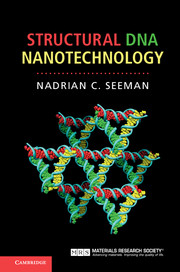Book contents
- Frontmatter
- Contents
- Preface
- 1 The origin of structural DNA nanotechnology
- 2 The design of DNA sequences for branched systems
- 3 Motif design based on reciprocal exchange
- 4 Single-stranded DNA topology and motif design
- 5 Experimental techniques
- 6 A short historical interlude: the search for robust DNA motifs
- 7 Combining DNA motifs into larger multi-component constructs
- 8 DNA nanomechanical devices
- 9 DNA origami and DNA bricks
- 10 Combining structure and motion
- 11 Self-replicating systems
- 12 Computing with DNA
- 13 Not just plain vanilla DNA nanotechnology: other pairings, other backbones
- 14 DNA nanotechnology organizing other materials
- Afterword
- Index
- References
11 - Self-replicating systems
Published online by Cambridge University Press: 05 December 2015
- Frontmatter
- Contents
- Preface
- 1 The origin of structural DNA nanotechnology
- 2 The design of DNA sequences for branched systems
- 3 Motif design based on reciprocal exchange
- 4 Single-stranded DNA topology and motif design
- 5 Experimental techniques
- 6 A short historical interlude: the search for robust DNA motifs
- 7 Combining DNA motifs into larger multi-component constructs
- 8 DNA nanomechanical devices
- 9 DNA origami and DNA bricks
- 10 Combining structure and motion
- 11 Self-replicating systems
- 12 Computing with DNA
- 13 Not just plain vanilla DNA nanotechnology: other pairings, other backbones
- 14 DNA nanotechnology organizing other materials
- Afterword
- Index
- References
Summary
This book is not about biology, but it is hard to separate DNA from biology. Nature uses DNA to store and replicate the information for living organisms, so it is natural to ask whether DNA motifs can be used to replicate information and to select materials that are the most propitious for particular environments. Replication can be used to provide exponential growth in molecular or cellular populations. However, one can ask whether there is any merit to doing that, rather than just making a large batch of whatever you want. Certainly chemicals are not produced by replication; when a large amount of material is wanted, the synthesis methods are just scaled up, from, say, the millimole scale to the mole scale.
Evolution and selection. The key element here is the notion of selection and evolution. If there are many different species produced, then it is useful to be able to select for the best one, given particular selection criteria. If there is a given circumstance existent in the medium, then it is useful to be able to select those individuals, be they molecules, cells, or larger organisms, that are best suited to survive under the selection criteria. If only those particular individuals survive the selection criteria, or if they are better suited to replicate, then self-replication is useful: the best-fitted individuals can then dominate the succeeding populations within that environment. This is hardly new wisdom. The nature of natural selection was pointed out by Darwin and Wallace in the nineteenth century. The idea of applying this notion to molecules (viral genomes) was first suggested by Spiegelman in the last third of the twentieth century, and then was taken up by Ellington and Szostak and by Tuerk and Gold some years later. In the latter cases, the investigators made partially random linear RNA molecules thought likely to fold to give a specific phenotype, either enzymatic or binding activity. Those molecules best suited to have this phenotype were selected and amplified repeatedly until a few molecular species dominated the population and their sequences could be identified.
Can the same thing be done with unusual DNA motifs? It is certainly an open challenge to optimize detailed structural properties in the 1–4 Å range based on selection procedures involving conventional phosphoramidites.
- Type
- Chapter
- Information
- Structural DNA Nanotechnology , pp. 186 - 197Publisher: Cambridge University PressPrint publication year: 2016



